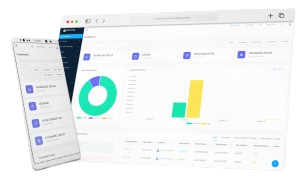Understanding the distinction between inventory and stock (inventory vs stock) is a huge step for any business looking to streamline operations and boost profitability. These two terms, often used interchangeably, represent different aspects of managing goods and materials. Grasping their unique roles can improve control over resources, improve operational efficiency, and enhance customer satisfaction.
At its core, inventory refers to all materials and products involved in a business—raw materials, work-in-progress items, and finished goods—while stock refers specifically to the finished goods ready for sale. This difference has significant implications for tracking, accounting, and optimizing resources.
For retailers and manufacturers alike, the ability to manage inventory and stock effectively is crucial. Poor management can lead to stock-outs, overstocking, and missed opportunities, all of which directly impact profitability. This guide will break down the key differences, explain their importance, and provide actionable strategies to help businesses optimize their processes.
Inventory vs Stock: Key Differences
While inventory and stock are related, understanding their distinctions is essential for effective management and profitability. These differences impact how businesses track, manage, and utilize goods across the supply chain.
What Is Inventory?
Inventory is the comprehensive term for all materials, goods, and assets a business holds. This includes:
- Raw materials used in production.
- Work-in-progress items still undergoing manufacturing.
- Finished goods awaiting sale or use.
In essence, inventory covers every stage of the product lifecycle, from raw materials to final products.
What Is Stock?
Stock, on the other hand, refers only to the finished goods ready for sale to customers. It is a subset of inventory and does not include raw materials or items still in production. Stock is what generates revenue directly for the business.
Key Differences at a Glance
| Aspect | Inventory | Stock |
| Definition | Includes raw materials, work-in-progress, and goods for sale. | Refers to finished goods ready for sale. |
| Scope | Broader; encompasses all assets related to production and sales. | Narrower; focuses on customer-ready products. |
| Replenishment | Tracked periodically (e.g., quarterly or annually). | Updated daily or in real-time. |
| Purpose | Determines overall business assets and costs. | Directly tied to revenue generation. |
| Relevance | Important for production and manufacturing. | Crucial for retail and sales operations. |
Why This Difference Matters
Recognizing the difference allows businesses to:
- Optimize resource allocation for production and sales.
- Avoid stock-outs and overstocking.
- Align accounting practices with operational goals.
By distinguishing inventory from stock, businesses can implement better strategies to track, manage, and utilize their resources effectively. This understanding forms the foundation for improving supply chain efficiency and meeting customer demand.
How Inventory and Stock Work Together
Inventory and stock are interconnected elements of a retail or manufacturing business. They work together to ensure smooth operations, customer satisfaction, and profitability. While their roles differ, they rely on each other to maintain balance across the supply chain.
The Relationship Between Inventory and Stock
- Inventory feeds stock: Raw materials and work-in-progress inventory are transformed into finished goods, adding to stock levels.
- Stock depletes inventory: As stock is sold or distributed, inventory must replenish the materials needed for future production or fulfillment.
For example, a furniture retailer’s inventory includes raw wood, screws, and upholstery. Once assembled, these materials become stock—ready-to-sell chairs and tables.
Why Both Are Important
- Meeting Demand: Stock ensures customer needs are met in real-time, while inventory planning ensures there’s enough supply to maintain stock levels.
- Cost Efficiency: Proper inventory management prevents overstocking and reduces waste. Stock control minimizes the risk of stock-outs, improving revenue potential.
- Operational Flow: Inventory supports long-term production, while stock supports short-term sales goals. Together, they create a seamless operational cycle.
How They Complement Each Other
- Inventory Planning: Helps forecast demand and align production schedules to ensure stock is always available.
- Stock Monitoring: Tracks sales patterns and customer preferences, offering data that feeds back into inventory decisions.
- Integrated Systems: Tools like inventory management software ensure real-time updates, synchronizing inventory and stock data across warehouses and stores.
Common Challenges in Managing Inventory and Stock
Managing inventory and stock effectively is a point for any retail or manufacturing business, yet it comes with several challenges that can disrupt operations and impact profitability. Understanding these obstacles is the first step toward addressing them.
Stock-Outs and Overstocking
- Stock-Outs: When items are unavailable, customers turn to competitors, leading to lost sales and reduced loyalty.
- Overstocking: Excess stock ties up capital, increases storage costs, and risks obsolescence.
Inaccurate Data
Without real-time updates, inventory counts may be incorrect, causing discrepancies that lead to poor decision-making and customer dissatisfaction.
Manual Processes
Manual inventory tracking is time-consuming and error-prone. Human errors in stock counts, reorder levels, or demand forecasting can lead to inefficiencies and unnecessary costs.
Lack of Visibility
Disjointed systems across warehouses, stores, and fulfillment centers make it difficult to gain a clear view of inventory and stock levels, leading to delays and mismanagement.
Changing Demand Patterns
Consumer preferences can shift rapidly, especially in omnichannel retail. Without accurate forecasting, businesses risk carrying outdated products or missing out on trending items.
Legacy Systems
Older inventory systems often lack the integration and automation required to support modern business needs, creating bottlenecks and inefficiencies.
Returns Management
Improper handling of returns can result in overstock, inventory miscounts, and increased operational costs.
How to Overcome These Challenges
- Implement Technology: Real-time inventory management systems can automate processes, minimize errors, and provide visibility.
- Optimize Replenishment: Use tools like reorder point calculations to balance stock levels effectively.
- Integrate Systems: Synchronize data across all channels to avoid silos and ensure accuracy.
- Monitor Trends: Stay updated on customer behavior to forecast demand accurately and plan inventory accordingly.
Tools and Solutions for Better Management
Effective inventory and stock management is required for business success, and leveraging the right tools and solutions can make all the difference. Here are some ways modern tools can streamline processes, reduce errors, and enhance operational efficiency.
Inventory Management Software
These systems automate stock tracking, reorder alerts, and real-time updates, ensuring accuracy and reducing the risk of overstocking or stock-outs. Popular examples include:
- ERP Systems: Centralize inventory, sales, and supply chain data.
- Standalone Inventory Tools: Offer focused solutions for small to mid-sized businesses.
Point-of-Sale (POS) Systems
Integrated POS systems update inventory levels as sales happen, giving you a real-time snapshot of stock. This is particularly useful for businesses with physical and online stores.
Barcode and RFID Technology
Simplify stock-taking with barcode scanning and RFID systems, which speed up data entry, reduce errors, and improve inventory tracking accuracy.
Demand Forecasting Tools
AI-powered forecasting tools analyze historical data, market trends, and seasonality to predict demand, helping you make smarter purchasing decisions.
Inventory Optimization Software
These tools use advanced algorithms to determine ideal stock levels, optimize replenishment cycles, and minimize holding costs.
Cloud-Based Solutions
Cloud-based platforms provide access to inventory data anytime, anywhere, ensuring better collaboration and decision-making across teams.
Integration Platforms
Seamlessly connect inventory systems with e-commerce platforms, suppliers, and warehouses to ensure data consistency and streamline operations.
Benefits of Modern Tools
- Efficiency: Automates time-consuming manual processes.
- Accuracy: Reduces human errors in stock counts and forecasting.
- Scalability: Adapts to the needs of growing businesses.
- Cost Savings: Minimizes storage and operational costs.
By adopting these tools and solutions, businesses can achieve better inventory and stock management, leading to reduced waste, improved customer satisfaction, and increased profitability.
Conclusion
Mastering inventory and stock management is not just about tracking numbers—it’s about optimizing your operations to drive efficiency, meet customer demand, and stay ahead in a competitive market. By understanding the distinctions between inventory and stock, recognizing their interplay, and addressing common challenges, businesses can lay the groundwork for seamless operations.
The key to success lies in leveraging the right tools and solutions tailored to your business needs. Whether it’s automating processes, improving accuracy, or gaining real-time insights, modern technology can transform how you manage inventory and stock.
Stay proactive, invest in scalable systems, and continuously refine your approach. With the right strategies, managing inventory and stock can become a streamlined process that propels your business toward sustained growth and success.






